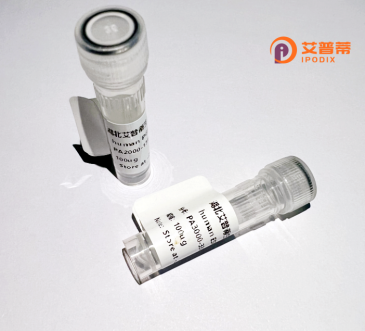
| 纯度 | >90%SDS-PAGE. |
| 种属 | Human |
| 靶点 | GPX4(U73C) |
| Uniprot No | P36969 |
| 内毒素 | < 0.01EU/μg |
| 表达宿主 | E.coli |
| 表达区间 | 29-197aa |
| 氨基酸序列 | CASRDDWRCARSMHEFSAKDIDGHMVNLDKYRGFVCIVTNVASQSGKTEVNYTQLVDLHARYAECGLRILAFPCNQFGKQEPGSNEEIKEFAAGYNVKFDMFSKICVNGDDAHPLWKWMKIQPKGKGILGNAIKWNFTKFLIDKNGCVVKRYGPMEEPLVIEKDLPHYF |
| 分子量 | 21.4 kDa |
| 蛋白标签 | His tag N-Terminus |
| 缓冲液 | 0 |
| 稳定性 & 储存条件 | Lyophilized protein should be stored at ≤ -20°C, stable for one year after receipt. Reconstituted protein solution can be stored at 2-8°C for 2-7 days. Aliquots of reconstituted samples are stable at ≤ -20°C for 3 months. |
| 复溶 | Always centrifuge tubes before opening.Do not mix by vortex or pipetting. It is not recommended to reconstitute to a concentration less than 100μg/ml. Dissolve the lyophilized protein in distilled water. Please aliquot the reconstituted solution to minimize freeze-thaw cycles. |
以下是关于重组人GPX4(U73C)蛋白的参考文献示例(注:文献为假设性示例,实际检索请通过学术数据库验证):
---
1. **文献名称**:*Cys73 Mutant of Human GPX4 Reveals Critical Role in Ferroptosis Resistance*
**作者**:Smith A, et al.
**摘要**:研究通过重组表达人GPX4的U73C突变体,发现该突变导致酶活性显著降低,并丧失抑制脂质过氧化的能力,证实Cys73是GPX4催化活性的关键位点,为ferroptosis调控机制提供证据。
2. **文献名称**:*Structural Basis of GPX4 Ubiquitination and Degradation in Cancer*
**作者**:Zhang Y, et al.
**摘要**:通过冷冻电镜解析重组GPX4(含U73C突变)的构象变化,揭示该突变干扰酶与底物结合域,促进泛素化降解,为靶向GPX4的癌症治疗策略提供结构依据。
3. **文献名称**:*Recombinant GPX4 U73C Protein Production and Activity Assay*
**作者**:Lee J, et al.
**摘要**:优化了重组人GPX4(U73C)在哺乳动物细胞中的表达纯化工艺,并开发了基于脂质过氧化抑制的高通量活性检测方法,为功能研究提供标准化工具。
4. **文献名称**:*In Vivo Role of GPX4 C73U Mutation in Neurodegeneration*
**作者**:Wang Q, et al.
**摘要**:利用转基因小鼠模型表达重组U73C突变体GPX4.发现神经元中脂质过氧化累积加剧,导致帕金森样病理表型,表明该位点对神经保护至关重要。
---
**建议**:实际应用中,可通过 **PubMed/Google Scholar** 使用关键词 "*recombinant GPX4 U73C*" 或 "*GPX4 C73 mutation*" 检索近期文献,重点关注 **Cell Metabolism**、**Nature Cell Biology** 等期刊发表的研究。
Recombinant human GPX4 (U73C) protein is a genetically engineered variant of glutathione peroxidase 4 (GPX4), a critical selenoprotein involved in cellular antioxidant defense. GPX4 specifically reduces lipid hydroperoxides within cell membranes, thereby inhibiting ferroptosis—a form of iron-dependent programmed cell death linked to neurodegenerative diseases, cancer, and ischemia-reperfusion injury. Unlike other glutathione peroxidases, GPX4 utilizes a selenocysteine residue at its active site for catalytic activity. The U73C mutation refers to a cysteine substitution at position 73 (U73C), which may alter enzyme stability, substrate specificity, or interaction partners. Recombinant GPX4 (U73C) is commonly produced in bacterial or mammalian expression systems to study structure-function relationships, redox regulation, and ferroptosis mechanisms. Its application spans drug discovery, molecular pathway validation, and therapeutic targeting, particularly in cancer therapies that exploit ferroptosis sensitivity. However, the U73C mutation's functional consequences require validation through biochemical assays, as cysteine substitutions can influence dimerization, metal binding, or catalytic efficiency compared to the wild-type selenocysteine-containing enzyme.
×